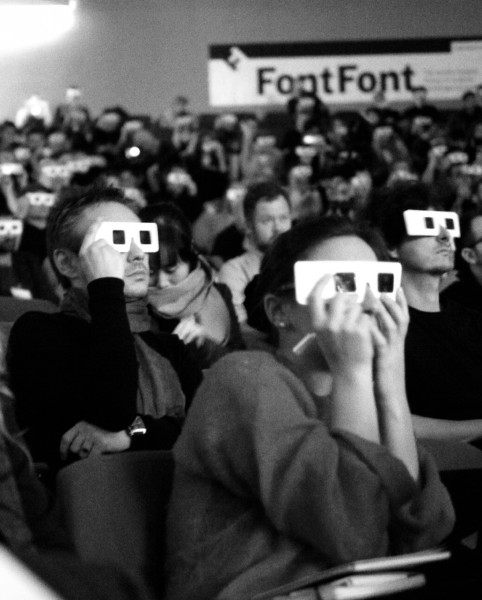
Photo: Thorsten Wulff
Wanting to look at this rectangle as the confines of the interface and then to push information back, bring it forward, give the user a genuine and dynamic involvement in the content is what is driving and fascinating him. Primarily, this is currently best evidenced in the choreography of menus on DVDs and the like, but increasingly the creativity of gaming offers interesting possibilities. This more immersive space is not just about making menus and chanel choices more interesting. Examples of work for CBS showed type in a dynamic setting where the written content moved with the surroundings to create a more dynamic experience.
If many of Dale’s examples stem from the world of entertainment and classic broadcast that doesn’t seem to limit the scope of his exploration (perhaps only the source of funding of the experimentation differs given the deeper pockets of gaming companies and broadcast organisations). So it was frustrating in some ways that the conclusion of Dale’s segment presented perhaps some of the most interesting questions, and possibilities. For example, what happens when we can take more control over advertising content, replacing the fixed unmoving bill board with a more immersive and self controlled advertising environment? What can we then switch on and off, speed through, or choose to take in? How will advertisers make the most of this new possibility?
Clearly, Dale is already at the front end of realising the possibilities that gestural control and 3D could offer and he’s already in the thick of testing out first principles with broadcasters and brands. At this point it may be worth a look ahead to the presentation due from Tim Fendley on Friday. The combination of wayfinding and gesture/3D control could start to get even more interesting. Ndeed, if Dale could be persuaded to stay on, there would be a fascinating discussion in the marriage of the challenges of self controlled information in a dimensional space and the important requirement of orientation and guidance in an urban context. Quite who would fund the exploration is anyone’s guess, but the results would certainly be worth waiting for.

Dale is a thought leader on the future of media consumption in an interactive and “many-screen” world of increasingly rich media interfaces. With an extensive background in Broadcast Design and branding, he was creative director of on-air design and branding for the three CBS Sports Winter Olympics broadcasts in the 1990s. Having his roots in the rich media approach to design in TV and film, he has pioneered a unique spatial approach to designing navigation systems for Interactive TV and connected screens. The work begins to blur the line between television, games and web, a concept he calls "New Television."
Dale was a part of the research team that developed the visionary gestural interfaces that first appeared in the film “Minority Report,” and is now leading development work in the rapidly emerging world of gestural navigation for screens at a distance. Screens have always defined unique spaces, and, particularly with advancements in stereo 3D projection and advanced AR, information can occupy these spaces. Spatial context is becoming increasingly important in design that is no longer flat: space and place are the new frontiers of design.
Dale has an MFA from California Institute of the Arts, where in 1981 he taught the first course in Motion Graphics offered to designers in the United States. He served on the founding advisory board of the digital content direction at the American Film Institute, and was an active participant in the development of advanced prototypes for Enhanced TV at AFI for many years. Dale has won four Emmy awards.
Dale was co-founder of interactive agency Schematic, which recently merged with three other agencies to become global powerhouse Possible Worldwide. He resides in London.
So, quite what we can expect when the rectangle finally bids us farewell is anyone’s guess. The next stage of the development of what this might become though is less about the shape that emerges and replaces it (‘cloud like’ was Dale’s suggestion) and more about considering what the user may genuinely require of such a change in our relationship with what currently remains flat unmoving space. This is way beyond entertainment, and though entertainment may help fund the exploration of possibilities, its true potential and impact will be founded in less trivial and more profound environments.
Text: Patrick Baglee, photo: Thorsten Wulff












 Photo: Thorsten Wulff
Photo: Thorsten Wulff











Pingback: Fontblog | TYPO London 2011 im Rückblick